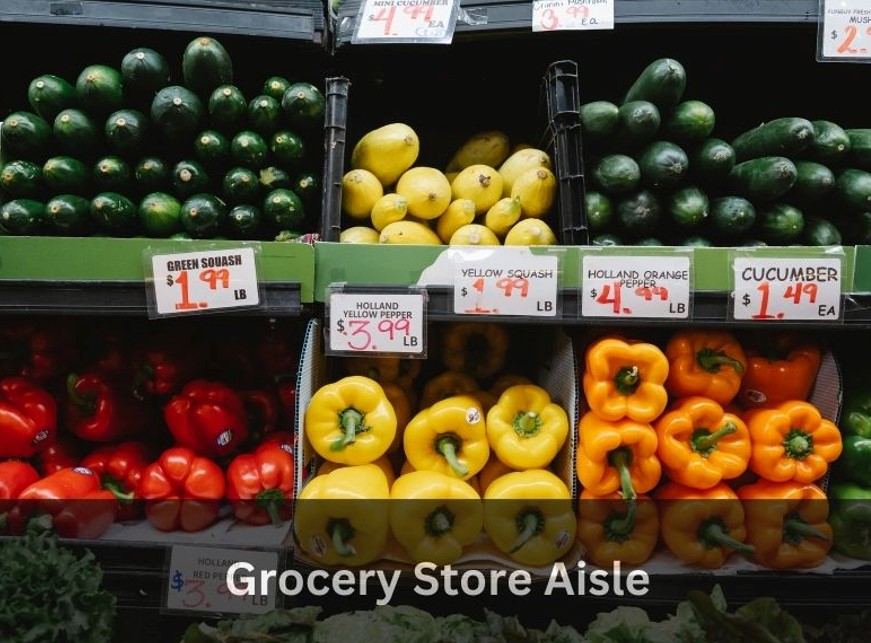Having a grocery store aisle map can help you shop more efficiently, save time, and make your trip easier. It also helps you get familiar with the layout of your favorite grocery store.
There are many different sections in the aisles of a grocery store, and each one is organized to group similar items together. This helps you find items faster and more easily, no matter what store you visit.
Fresh Meat
If you’re looking to get a steak, chicken breast or some other type of meat, the grocery store aisle is where you’ll find it. This department may only include fresh and frozen packaged meat, but larger stores will have a full-service butcher where you can get things cut to order.
Meat is a popular and delicious food, but it’s also easy to spoil. That’s why grocery stores strictly monitor cooler and freezer temperatures to keep their meat fresh.
In addition, they restrict human contact with the meat and only offer custom cuts if a customer requests them. This helps to reduce the risk of cross-contamination and improves the quality of the meat.
Another way to help keep fresh meat fresh is by using Modified Air Packaging. This technique seals out oxygen from case-ready meat, so the bright cherry-red color stays on that fresh steak for as long as possible.
Fresh Vegetables
The produce section in most grocery stores is a popular draw for shoppers. Seeing brightly colored produce at the front of the store makes them feel healthier and more likely to buy it (per National Geographic).
When deciding what to purchase, look for fruits and vegetables that are fresh. Avoid those that are wilted, bruised or damaged. The surface should be smooth and even, without pits or dents that could cause them to rot quickly.
Fruits and vegetables are also seasonal, meaning that certain varieties ripen during specific times of the year. These include berries, which are sweeter in spring and summer, and root vegetables, which peak in fall through spring.
Grocery stores also offer a wide variety of organic produce. Some of the most popular types include broccoli, kale, arugula and spinach. While the selection varies from store to store, it is generally healthier than non-organic options.
Dairy
Dairy products are a vital part of a well-rounded diet. Milk, cheese, yogurt and ice cream are all staples in many people’s kitchens. But there are also nondairy options available, such as almond, soy and coconut milk.
The dairy aisle is the most extensive section in a grocery store. It sells a wide variety of milk-based desserts, different types of yogurt and ice cream.
This is a highly-trafficked area of the store, so it needs to be organized and easily accessible for customers. This is why grocers are using pusher display systems to keep the shelves organized and front-faced.
Another food product that often finds its way into the dairy section is eggs. This is due to the fact that eggs are best when kept cold, and dairy aisles often have plenty of refrigeration space.
In addition to the dairy aisle, grocery stores have a dry foods section that sells things like cereal, candy, pasta, snacks and other items that don’t need to be chilled or frozen. These products are generally low in fat, sugar and calories.
Bakery
The bakery aisle in the grocery store has a lot of different products. In this aisle, you can find baking essentials like flour, sugar, baking powder, salt, eggs and milk. There are also baking mixes, chocolate chips and frostings.
Bakery products can be found in any grocery store. They include bread, cookies, cakes, pies and donuts.
Some bakeries even specialize in specific types of products, such as artisan bread. While these specialty bakeries can cost more than grocery store options, they offer a wide range of baked goods and are often worth the extra money.
Aside from bread, the baking aisle is home to a large variety of herbs and spices. The seasonings in this section can be used to make a wide variety of dishes, from salads and stews to soups and even desserts. It’s a good idea to stock up on fresh herbs and spices when they’re in season. It’s also a great time to replace the ones that have lost their potency.
Beverages
If you love drinking, you’ll find a lot of different beverages in the grocery store aisle. It’s a great place to find soft drinks, juice drinks, water, sports drinks, and energy drinks.
You can also find a variety of flavored sodas, including root beer and ginger ale. This is a great way to try new flavors without having to buy a whole case of each one.
Despite the popularity of flavored water and other non-alcoholic beverage options, many Americans still enjoy drinking alcohol. In fact, it’s becoming more popular among Millennials and Gen Zers.
This is a growing trend that’s making it difficult for grocery stores to compete in this segment. As a result, retailers are looking for ways to increase sales of alcohol products, such as adding more alcohol departments to the store or promoting specific price promotions for alcohol.
Another strategy is to put more shelf space toward healthier drinks, like sparkling juices and functional bottled water. This strategy will align business and public interests, CSPI says, and it can boost sales of these healthy options.
Organic Food
The organic food aisle in most grocery stores contains everything from organic fruits and vegetables to a wide variety of other fresh and processed foods. It’s also commonly found alongside the paper products and cleaning supplies sections.
The main reason consumers opt for organic food is because it contains less pesticides and chemical preservatives than conventionally produced foods. It’s also a healthier alternative for those who suffer from allergies or who are concerned about environmental pollution.
A good place to start deciding which foods you should buy organic is by reading the labels. Some sources, such as the Environmental Working Group’s Shopper’s Guide to Pesticides in Produce and Consumer Reports’ Pesticides in Produce Special Report, offer lists of which foods typically contain the highest levels of pesticide residues and which ones are best suited for organic purchasing.
You can also start by focusing on the types of food you eat most often. For example, family meals are likely to include dairy, eggs, and bread, so choosing larger sizes of these items can be a smart choice.
Paper Products
The paper products section of a grocery store aisle usually contains toilet paper, napkins, and garbage bags. It may also include cleaning supplies, like bathroom cleaners and multipurpose laundry detergent.
Kraft paper is a good choice for wrapping meat and storing it in the fridge or freezer because it absorbs moisture and prevents bacteria growth. It can be used to wrap brisket, pork shoulder, and other cuts of meat that need to be refrigerated or frozen.
It can also be used to cover vegetables or other foods that need to be rehydrated. Its odor-absorbing qualities can help keep the fresh flavor of the food.
Manufacturers are introducing new products that are more environmentally friendly, such as recycled “earth first” paper towels, bath tissue and facial tissues. These items are increasingly popular with carbon footprint-conscious shoppers, according to industry experts.
Retailers can drive sales and profits in this category by increasing merchandising, promotions and floor space for consumer paper products. They should focus on driving engagement with bundling and cross-category promotions, says manufacturers.
Cleaning Supplies
Grocery stores are one of the busiest places in the country and it is essential that all areas are cleaned properly. Not only does a clean store look better, but it also encourages customer loyalty and increases the chance of a sale.
As a result, grocery stores need the full range of cleaning products, from disinfectants to floor cleaners. Not only does this keep customers and employees safe, but it ensures the integrity of the food that they buy.
A well-organized store can also be a benefit to shoppers, since it helps them easily find what they are looking for and ensures that they do not buy items that are expired or damaged. A clean store also allows for easier inventory management, a positive atmosphere and fewer health concerns among shoppers and staff members.
Another area of the grocery store that should be given extra attention is the restrooms. Keeping the bathrooms clean and sanitized on a regular basis will help prevent germs and bacteria from spreading throughout the store, as well as reduce odors and improve employee morale.




